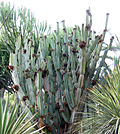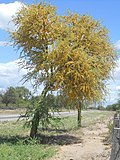Xerophyte
Xerophyte
A Xerophyte is a species of plant that has adapted to survive in an environment with little liquid water, such as an arid desert or an ice- or snow-covered region in the Alpine tundra. Xerophytes have adapted to be able to survive in these conditions, which are extreme for most plants.
Characteristics[edit]
Xerophytes have a number of adaptations that enable them to survive in dry environments. These include:
- Stomata that can open to allow air in and close to prevent water loss.
- Cuticles that are thick and waxy to reduce water loss.
- Leaf size and shape that reduces the surface area exposed to the air, reducing water loss.
- Root systems that are extensive and can reach deep into the soil to access water.
- Succulence, or the ability to store water in their leaves, stems, and roots.
Types of Xerophytes[edit]
There are several types of xerophytes, including:
- Ephemerals, which complete their life cycle during periods of available moisture, and survive dry periods as seeds.
- Succulents, which store water in their leaves, stems, and/or roots.
- Non-succulent perennials, which have adaptations such as small leaves and deep roots to survive dry periods.
- Shrubs and trees, which have deep root systems and thick bark to reduce water loss.
Examples of Xerophytes[edit]
Some examples of xerophytes include:
- The cactus family, which includes many succulent xerophytes.
- The Aloe genus, which includes many succulent xerophytes.
- The Agave genus, which includes many succulent xerophytes.
- The Joshua tree, a non-succulent perennial xerophyte.
See also[edit]
References[edit]
<references />
Ad. Transform your life with W8MD's Budget GLP-1 injections from $75


W8MD offers a medical weight loss program to lose weight in Philadelphia. Our physician-supervised medical weight loss provides:
- Weight loss injections in NYC (generic and brand names):
- Zepbound / Mounjaro, Wegovy / Ozempic, Saxenda
- Most insurances accepted or discounted self-pay rates. We will obtain insurance prior authorizations if needed.
- Generic GLP1 weight loss injections from $75 for the starting dose.
- Also offer prescription weight loss medications including Phentermine, Qsymia, Diethylpropion, Contrave etc.
NYC weight loss doctor appointmentsNYC weight loss doctor appointments
Start your NYC weight loss journey today at our NYC medical weight loss and Philadelphia medical weight loss clinics.
- Call 718-946-5500 to lose weight in NYC or for medical weight loss in Philadelphia 215-676-2334.
- Tags:NYC medical weight loss, Philadelphia lose weight Zepbound NYC, Budget GLP1 weight loss injections, Wegovy Philadelphia, Wegovy NYC, Philadelphia medical weight loss, Brookly weight loss and Wegovy NYC
|
WikiMD's Wellness Encyclopedia |
| Let Food Be Thy Medicine Medicine Thy Food - Hippocrates |
Medical Disclaimer: WikiMD is not a substitute for professional medical advice. The information on WikiMD is provided as an information resource only, may be incorrect, outdated or misleading, and is not to be used or relied on for any diagnostic or treatment purposes. Please consult your health care provider before making any healthcare decisions or for guidance about a specific medical condition. WikiMD expressly disclaims responsibility, and shall have no liability, for any damages, loss, injury, or liability whatsoever suffered as a result of your reliance on the information contained in this site. By visiting this site you agree to the foregoing terms and conditions, which may from time to time be changed or supplemented by WikiMD. If you do not agree to the foregoing terms and conditions, you should not enter or use this site. See full disclaimer.
Credits:Most images are courtesy of Wikimedia commons, and templates, categories Wikipedia, licensed under CC BY SA or similar.
Translate this page: - East Asian
中文,
日本,
한국어,
South Asian
हिन्दी,
தமிழ்,
తెలుగు,
Urdu,
ಕನ್ನಡ,
Southeast Asian
Indonesian,
Vietnamese,
Thai,
မြန်မာဘာသာ,
বাংলা
European
español,
Deutsch,
français,
Greek,
português do Brasil,
polski,
română,
русский,
Nederlands,
norsk,
svenska,
suomi,
Italian
Middle Eastern & African
عربى,
Turkish,
Persian,
Hebrew,
Afrikaans,
isiZulu,
Kiswahili,
Other
Bulgarian,
Hungarian,
Czech,
Swedish,
മലയാളം,
मराठी,
ਪੰਜਾਬੀ,
ગુજરાતી,
Portuguese,
Ukrainian













